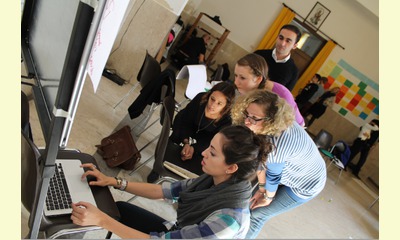|
|
International Conference: The role of young people in peacebuilding and social change [Italy]
un articulo por Marta Borkowska, CEIPES
25 participants from all over the Europe had an opportunity to take active part in the International Conference, which was held in Palermo, Italy, from 20th to 25th of November 2012. The event was organised by CEIPES in cooperation with UNOY Peacebuilders (Netherlands), Fundacion Catalunya Voluntaria (Spain) and PATRIR (Romania).

click on photo to enlarge
Our conference ‘The role of young people in peacebuilding and social change: good practices and future perspectives’ was the response to the increasing interest and motivation of young people to change the current situation, of which they are very much aware. During the four days of the conference, the participants gained theoretical and practical knowledge about the issues related to peace, culture of peace, social change, peacebuilding, conflict and conflict transformation.
Every activity involved non-formal education and was designed to meet participants’ needs and expectations. Hence, their skills wer developed by not only taking part in workshops related to art, but also running their own workshops about the best peace practice in their homelands and discussing the problem with local people during the "city game." Participants educated each other about volunteering in countries such as Cambodia, Philipines and Sudan, as well as methods of spreading peace and conflict transformation.
The specific objectives of the conference were:
1. To create a space where young people can share their experiences in peacebuilding and human rights education.
2. To share new methods on peace education and human rights education specifically in the field of arts.
3. To inspire young people to engage in peacebuilding, namely, to foster in young people the motivational and social competencies for peace.
4. To reinforce the cohesion among the group of participants as a mean to favour the follow up and networking.
5. To foster learning on peacebuilding and conflict transformation.
To a great extent, the team was motivated to engage in peacebuilding, and they received new ideas of how to encourage other people to take part in all of the activities related to peace and culture of peace. Here are some of their comments:
'I really appreciated learning new techniques and methods such as using mime, the movement workshop, the real life experiences on peacebuilding and international volunteering, the theatre of the oppressed and the peace murals.'
'It gave me an overview of the topic, peacebuilding and social change in a really understanding way, making us a little more aware of what we can do, the tools we have, that we are not alone and the youth in Europe are conscious about world realities.'
'We came together with different experiences and levels of engagement, asserting the values of holistic, artistic approaches to peace, and learning different methods of engagement from the others.'
The project was funded with the financial support of the European Youth Foundation of the Council of Europe.
|








|
DISCUSSION
Pregunta(s) relacionada(s) al artículo :
Is there a renewed movement of solidarity by the new generation?,
* * * * *
Comentario más reciente:
from Javier Collado Ruano, Director of Edition at Global Education Magazine, on the occasion of the International Day of Solidarity.
Solidarity is a trans-dimensional phenomenon that goes beyond the ontological essence of human nature. In fact, when we analyze the connections between the microcosm and the macrocosm, we perceive that human beings are not involved in chaos and arbitrariness, but belongs to the large network of interdependencies, complementarities and reciprocities that constitute life. The emergence of life on Earth, around 3,8 billion years ago, was a complex process of exceptional natural phenomena, inherent in all living systems. A process which is expressed through unlimited creativity: mutation, gene exchange, and symbiosis. From a cosmo-biological perspective, we can understand a new conceptual dimension of life, where all living beings share same basis of genetic code: the twenty amino-acids and four phosphatic bases. In fact, the diversity of living beings is caused by the combination of this cosmo-bio-genetic basis.
This trans-dimensional perspective has a deep ecological and spiritual sense for our worldview because the human evolutionary adventure is the latest stage of life on Earth. The modern human being is a vertebrate animal, mammal, belonging to the primates, which emerged 200,000 years ago. In recent centuries he has imposed its anthropocentric, industrial and capitalist vision to the detriment of Pachamama (and Indigenous goddess known as earth mother). We consume around 120% of the natural resources that Earth Mother regenerats annually. Our consumer behavior is immersed in a fatalistic dynamic with a destiny to climate change (deforestation, loss of biodiversity, ozone, etc.), and our own self-destruction as a species.
There is an urgent need to get beyond the cognitive fallacy that the mental structures of social Darwinism and capitalist postulates of the 19th century have historically constituted, because they only understand natural and social systems as warmongers and competitive processes whereby species diverge from each other. . ... continuación.

|
|









